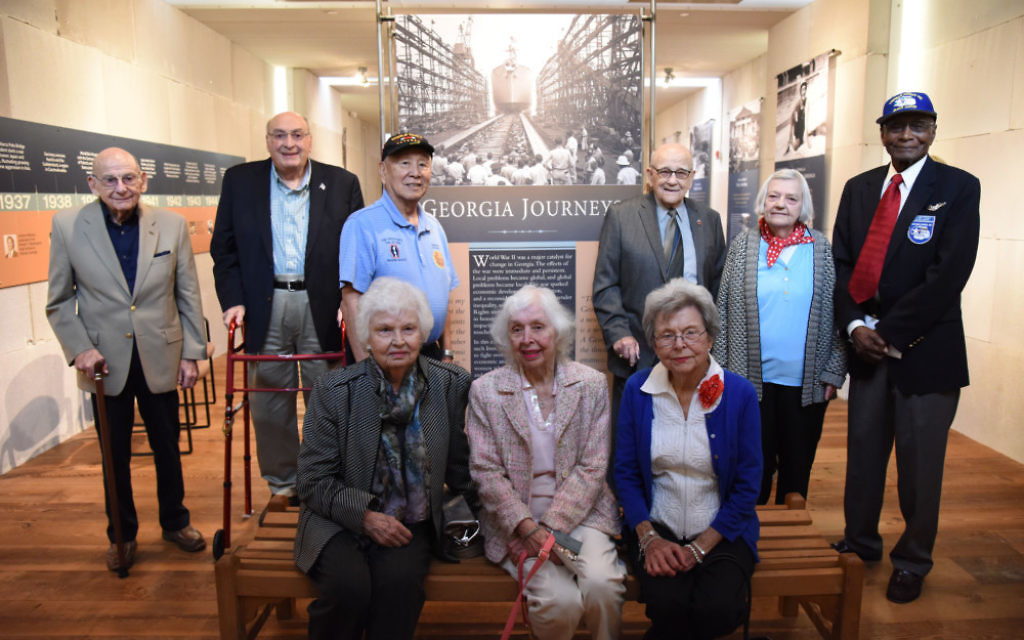KSU Museum Tracks Overlapping Ga. Journeys

A new exhibit at Kennesaw State University’s Museum of History and Holocaust Education, just east of Interstate 75 at Exit 271, offers a fresh and refreshingly personal look at the members of the Greatest Generation.
“Georgia Journeys,” which opened in late October, in some ways takes a familiar approach to the museum’s mission to provide World War II and Holocaust education with its free exhibits. Like the 10-year-old “Parallel Journeys,” this show taps into Kennesaw State’s repository of recorded personal histories to bring the scope of that epic era down to a relatable, individual level.

As the title indicates, the 12 people featured in this exhibit — 13 if you count part-time Georgian Franklin Delano Roosevelt, who curator Adina Langer said gets his own panel to provide the big picture — lived in Georgia at the time of World War II or later settled in the state.
Get The AJT Newsletter by email and never miss our top stories Free Sign Up
They fit into three broad categories: Holocaust survivors, war veterans and people on the home front. But life is complicated, so categories overlap.
There are four Holocaust survivors:
- Andre Kessler, who not only went on to serve in the Navy in the 1950s, but also played two years of NBA basketball alongside Wilt Chamberlain on the Philadelphia Warriors.
- Herbert Kohn, whose family was able to escape Germany and move to a farm in Alabama in 1940 in part because of his father’s distinguished record for the German army in World War I, in which both of his grandparents also fought. Kohn then served in the U.S. Army for the last two years of World War II.
- Norbert Friedman, who did time in 11 Nazi camps before being liberated May 1, 1945, by the U.S. Army, for which he then provided translation services.
- Tosia Schneider, who lost both her parents and her brother in Nazi-occupied Poland but managed to make it to America after the war.
All four have worked with the Breman Museum, which provided some materials for this exhibit.
“The museum community here in Atlanta is collegial and tight-knit and very response to requests for assistance,” Langer said, also mentioning the assistance of the Atlanta History Center and the state Department of Natural Resources.
Among the other eight people featured, Tooken Richardson Cade, Louvinia Jordan and Jane Tucker spent the war on the U.S. home front, although not necessarily in Georgia. Jimmy Doi at first was limited to a different home front existence, held in an internment camp with other Japanese-Americans, but he and his three brothers all fought for the United States.

Also representing veterans are Tuskegee Airman Hillard Pouncy, who went on to be a chemist; Alton Cadenhead, whose service with the Marines took him to Iwo Jima; Guy Gunter, who flew a glider behind enemy lines on D-Day; and Lorenzo Wallace, who was among the first blacks to enlist in the Marines.
“One of the comments that came out of the opening was just the astonishment at how powerful these stories are when you hear them from the people who lived them,” Langer said.
That’s one of the differences between “Georgia Journeys” and “Parallel Journeys”: the extensive use of interviews on video as well as a range of artifacts to bring the stories to life.
Langer said she was hired a little over a year ago with a mandate to bring new interpretative approaches to the museum’s exhibits, and that’s what she has done. Whereas “Parallel Journeys” involves looking at a few photos and lots of reading, the new exhibit enables visitors to interact and learn in different ways.
A World War II-era living room, for example, plays authentic audio from the 1940s, including reports on the war. You can touch and pick up items such as scrapbooks. Maps and timelines help tie the 12 individual journeys and the bigger world story together.
Those intersection points are important, Langer said, because they correct the tendency to study and think about the Holocaust and World War II as if they aren’t connected, even though they are.

The museum soon will install two iPads so visitors can access the digital side of the exhibit, a new element people can view anywhere.
The bigger picture for Kennesaw State is that “Georgia Journeys” represents the second part of a three-phase plan to enhance the museum, Langer said. The first phase was the introduction of some of the museum’s rotating exhibits into a hall space near the staff offices.
The third phase, whose fruits Langer said we should see next fall, includes an overhaul of the decade-old “V for Victory” exhibit.
And while the “Georgia Journeys” exhibit is a permanent part of the museum, it could evolve as the museum captures as many personal histories as possible while members of the World War II generation remain.
Swing Shift
The Museum of History and Holocaust Education is holding a free swing dance (1940s attire optional) on Saturday night from 7 to 10 at the KSU Center, 3333 Busbee Drive, Kennesaw. A big band, Sentimental Journey, will supply the music; you just need to bring a nonperishable food item for Feed the Future, which helps food-insecure Kennesaw State students.




comments